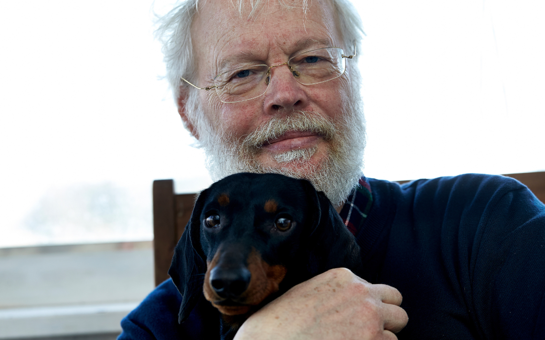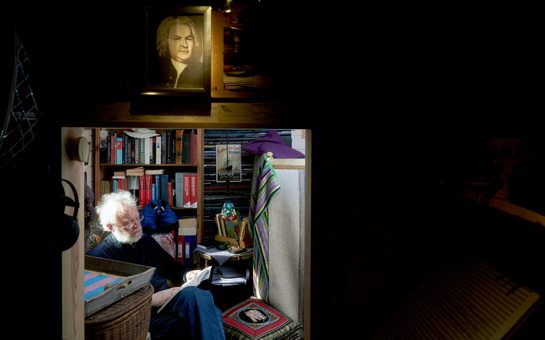- Poul Ruders
Symfoni nr. 1 (1989)
(Symphony no. 1)- Edition Wilhelm Hansen Copenhagen (World)
Himmelhoch Jauchzend - zum Tode betrübt
- 4.4.4.ssx.4/6.4.4.1/timp.4perc/hp/pf/epf/syn/str
- 33 min
Programme Note
"Himmelhoch jauchzend - zum Tode betrübt"
1. Presto jubilante - Triste - Furioso fantastico
2. Tranquillo molto; dolcissimo
3. Scherzando prestissimo -
4. Maschera funerale
In 1969, having composed only two pieces, one for piano and one for organ, I was carried away by an overwhelmingly persistent wave of youthful ‘Sturm und Drang’, and wrote a chamber piece entitled Himmelhoch jauchzend - zum Tode betrübt: quite a mouthful for a twenty-year-old. Later on I withdrew the piece for many reasons, but the title - a quotation from Goethe’s Egmont (Klärchen’s song) - has lingered with me ever since. The commission form the BBC caught me at the right time. Having recently completed three solo concertos (The Drama Trilogy), I very much wished to sum up the last twenty years’ compositional development in ‘pure’ orchestral music, and the idea of the result being my first symphony came into focus.
Today the word ‘symphony’ implies a spiritual profundity rather than mere perfection of form; in many ways the word is archaic, as is its literary equivalent, ‘novel’; but there is no better label to put on a long, substantial tale, and the inherited momentousness of the concept ‘symphony’ makes it a comprehensible, as well as a fully justified, headline for an abstract, metaphysically loaded musical narrative. Interestingly enough, it is about the only one of the ‘classic’ titles that still prevails: a few ‘sonatas’ are still written, admittedly, while the words ‘string quartet’ only tell us about the sort of ensemble involved; but ‘symphonies’ are written all over the place, the title often being a mere indication of the composition’s status, as with ‘for orchestra’.
Recognizing my own rather mercurial temperament, I decided finally to make use of the old/young infatuation with the Goethe quotation - this time as a subtitle to the symphony. The title indicates two ‘solutions’: ‘Exulting to the heavens - grieving unto death’ (and back to joy again, perhaps); or one might choose a pessimistic approach, and stop with only a glimpse of hope, which I felt was my only option.
At first I thought that I would write the piece in an uninterrupted stretch, but decided against this because a long piece is easier to remember when divided into movements. The first is ‘an architect’s model’ of the subtitle per se: the emotional and dynamic levels are presented on all levels; the indication ‘Presto jubilante-Triste-Furioso fantastico’ is only the basic scaffolding. Two layers from the opening of Bach’s Christmas Oratorio, the fast, descending D major sequence and the jubilant chorale outburst ‘Jauchzet, frohlocket’ open the movement in a full, dramatic, orchestral clash and prevail throughout, but in a rapidly growing disguise of despair and darkness; the recitative in which King Herod falsely displays his loving care for the new-born king of the Jews appears on top of a chromatic, ever-descending weeping motif in the woodwind. In the middle section (Triste) is heard, on the lonely piccolo and piano, a popular, pre-reformation German Christmas Carol, but in a bleak context with low winds and strings. Thus the ancient concept of Yuletide as happy, a harbinger of peace for all mankind, collides with our knowledge of modern Christmas deprived of innocence. The movement concludes as a terrifyingly fast and ferocious ‘mirage’ of the opening rejoicing.
The second movement (Tranquillo molto, dolcissimo) is merely activated silence: only two chords are heard, B flat minor and D flat major simultaneously. This melancholy haze of sound remains for ten minutes, kept breathing only by the minutest possible rhythmic alterations in the static orchestration. (While writing this movement I had in mind two terms used by Milan Kundera: ‘The Desert of Time/the horror of constancy’: ‘...the desert of time [emerged] from the half-light, frightening and oppressive like Eternity’.) In order not to make the last chord appear too final, I broke up the frozen harmony by letting the muted trumpets play E flat and G natural inside the basic B flat minor/D flat major amalgam (already augured in the first movement in the Triste section), thus leading this ‘eye of the hurricane’ into the remaining two movements, which are played without pause.
The vivid Scherzando prestissimo is in fact a prolonged upbeat (of whirling woodwind/percussion cascades around a patiently rising horn-hymnal) to the forth movement. This ‘Maschera funerale’ (‘Death Mask’) is, like the second movement, one sound, but here it is a huge, chromatic cluster, slowly pared away over a time-span of seven minutes, the force keeping it alive being the ultra-high speed of the scherzo (half-note = 96, which is then gradually lowered to half-note = 44). Thus the facial features of the piece stiffen into a symphonic ‘tundra’: the heartbeat and changing colours of the first movement freeze into one, glacial entity. But I do allow a door to open towards the very end by inserting, very sotto voce, a recognisable recapitulation of one of the brass chorales from the first movement. Ending this way, with piano and solo violin revisiting the gentle German Christmas Carol, enables me to proceed from there in a future piece, when perhaps I will climb towards a lighter level. But with ‘Himmelhoch jauchzend – zum Tode betrübt‘ pessimism is there; it’s a fact, but never the goal.
- Poul Ruders
1. Presto jubilante - Triste - Furioso fantastico
2. Tranquillo molto; dolcissimo
3. Scherzando prestissimo -
4. Maschera funerale
In 1969, having composed only two pieces, one for piano and one for organ, I was carried away by an overwhelmingly persistent wave of youthful ‘Sturm und Drang’, and wrote a chamber piece entitled Himmelhoch jauchzend - zum Tode betrübt: quite a mouthful for a twenty-year-old. Later on I withdrew the piece for many reasons, but the title - a quotation from Goethe’s Egmont (Klärchen’s song) - has lingered with me ever since. The commission form the BBC caught me at the right time. Having recently completed three solo concertos (The Drama Trilogy), I very much wished to sum up the last twenty years’ compositional development in ‘pure’ orchestral music, and the idea of the result being my first symphony came into focus.
Today the word ‘symphony’ implies a spiritual profundity rather than mere perfection of form; in many ways the word is archaic, as is its literary equivalent, ‘novel’; but there is no better label to put on a long, substantial tale, and the inherited momentousness of the concept ‘symphony’ makes it a comprehensible, as well as a fully justified, headline for an abstract, metaphysically loaded musical narrative. Interestingly enough, it is about the only one of the ‘classic’ titles that still prevails: a few ‘sonatas’ are still written, admittedly, while the words ‘string quartet’ only tell us about the sort of ensemble involved; but ‘symphonies’ are written all over the place, the title often being a mere indication of the composition’s status, as with ‘for orchestra’.
Recognizing my own rather mercurial temperament, I decided finally to make use of the old/young infatuation with the Goethe quotation - this time as a subtitle to the symphony. The title indicates two ‘solutions’: ‘Exulting to the heavens - grieving unto death’ (and back to joy again, perhaps); or one might choose a pessimistic approach, and stop with only a glimpse of hope, which I felt was my only option.
At first I thought that I would write the piece in an uninterrupted stretch, but decided against this because a long piece is easier to remember when divided into movements. The first is ‘an architect’s model’ of the subtitle per se: the emotional and dynamic levels are presented on all levels; the indication ‘Presto jubilante-Triste-Furioso fantastico’ is only the basic scaffolding. Two layers from the opening of Bach’s Christmas Oratorio, the fast, descending D major sequence and the jubilant chorale outburst ‘Jauchzet, frohlocket’ open the movement in a full, dramatic, orchestral clash and prevail throughout, but in a rapidly growing disguise of despair and darkness; the recitative in which King Herod falsely displays his loving care for the new-born king of the Jews appears on top of a chromatic, ever-descending weeping motif in the woodwind. In the middle section (Triste) is heard, on the lonely piccolo and piano, a popular, pre-reformation German Christmas Carol, but in a bleak context with low winds and strings. Thus the ancient concept of Yuletide as happy, a harbinger of peace for all mankind, collides with our knowledge of modern Christmas deprived of innocence. The movement concludes as a terrifyingly fast and ferocious ‘mirage’ of the opening rejoicing.
The second movement (Tranquillo molto, dolcissimo) is merely activated silence: only two chords are heard, B flat minor and D flat major simultaneously. This melancholy haze of sound remains for ten minutes, kept breathing only by the minutest possible rhythmic alterations in the static orchestration. (While writing this movement I had in mind two terms used by Milan Kundera: ‘The Desert of Time/the horror of constancy’: ‘...the desert of time [emerged] from the half-light, frightening and oppressive like Eternity’.) In order not to make the last chord appear too final, I broke up the frozen harmony by letting the muted trumpets play E flat and G natural inside the basic B flat minor/D flat major amalgam (already augured in the first movement in the Triste section), thus leading this ‘eye of the hurricane’ into the remaining two movements, which are played without pause.
The vivid Scherzando prestissimo is in fact a prolonged upbeat (of whirling woodwind/percussion cascades around a patiently rising horn-hymnal) to the forth movement. This ‘Maschera funerale’ (‘Death Mask’) is, like the second movement, one sound, but here it is a huge, chromatic cluster, slowly pared away over a time-span of seven minutes, the force keeping it alive being the ultra-high speed of the scherzo (half-note = 96, which is then gradually lowered to half-note = 44). Thus the facial features of the piece stiffen into a symphonic ‘tundra’: the heartbeat and changing colours of the first movement freeze into one, glacial entity. But I do allow a door to open towards the very end by inserting, very sotto voce, a recognisable recapitulation of one of the brass chorales from the first movement. Ending this way, with piano and solo violin revisiting the gentle German Christmas Carol, enables me to proceed from there in a future piece, when perhaps I will climb towards a lighter level. But with ‘Himmelhoch jauchzend – zum Tode betrübt‘ pessimism is there; it’s a fact, but never the goal.
- Poul Ruders
Media
Scores
Score preview
Discography
More Info

- Poul Ruders’ symphonies collected in new box set
- 3rd October 2025
- New album release out on Bridge Records

- World Premiere of Poul Ruders' new symphony
- 12th November 2024
- Odense Symphony Orchestra presents the World Premiere of Poul Ruders' 'Symphony No.6'

 Located in the UK
Located in the UK
 Located in the USA
Located in the USA
 Located in Europe
Located in Europe